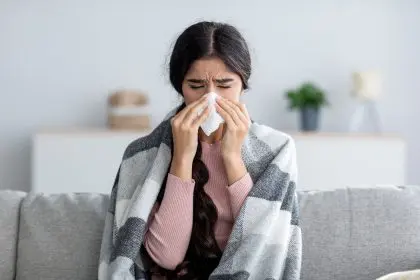Indoor environments often contain substances that may affect health and well-being. From cleaning products to furniture, everyday household items can release compounds that accumulate in air and dust. Making strategic adjustments to common household products and practices can significantly reduce exposure to potentially harmful substances.
These modifications don’t require complete home renovations or major investments—small, deliberate changes can make meaningful differences in creating healthier living spaces.
Cleaning product alternatives
Conventional cleaning supplies frequently contain harsh chemicals that may irritate respiratory systems and skin:
Natural substitutes: Simple ingredients like white vinegar, baking soda and lemon juice effectively handle many household cleaning tasks.
Commercial options: Plant-based and non-toxic labeled products offer effective cleaning with fewer potentially harmful ingredients.
Reading product labels carefully helps identify cleaners without ammonia, chlorine bleach or synthetic fragrances, which can trigger respiratory sensitivity in some individuals.
Fragrance considerations
Synthetic fragrances permeate many household products and may contain dozens of undisclosed chemicals:
- Air fresheners and scented candles often include phthalates and other synthetic compounds
- Fragranced laundry products leave residues on clothing that maintain ongoing exposure
- Many scented products release volatile organic compounds (VOCs) that affect indoor air quality
Switching to fragrance-free products or using essential oil diffusers provides aromatic alternatives without the complex chemical mixtures found in synthetic fragrances.
Water filtration options
Tap water quality varies significantly by location and may contain various contaminants despite meeting regulatory standards:
Filtration systems: Options range from simple pitcher filters to more comprehensive under-sink systems that target specific contaminants.
Targeted removal: Different filtration technologies address particular concerns—activated carbon for chlorine and organic compounds, reverse osmosis for a broader range of contaminants.
Water testing kits can help identify which specific filtration approach best addresses local water quality issues.
Plastic reduction strategies
Food containers and kitchenware made from plastic can leach chemicals into food, particularly when heated:
Storage alternatives: Glass, stainless steel and ceramic containers provide non-reactive food storage options.
Food wrapping: Beeswax wraps, parchment paper and silicone covers offer functional replacements for plastic cling films.
Cooking considerations: Replacing plastic utensils and non-stick cookware with stainless steel, cast iron or ceramic options reduces exposure to synthetic materials during food preparation.
These kitchen adjustments particularly benefit foods with higher fat content, which more readily absorb chemicals from plastic containers.
Furniture and decor improvements
Home furnishings often contain flame retardants, stain repellents and other treatments that may off-gas into indoor air:
Material selection: Furniture made from solid wood, metal or natural fibers typically contains fewer synthetic additives than pieces with particle board or polyurethane foam.
Emission reduction: Looking for Greenguard certification or other low-VOC designations helps identify pieces manufactured to limit chemical emissions.
Air purification: Certain houseplants like peace lilies, boston ferns and spider plants can help filter indoor air, though their effects are modest compared to mechanical air purifiers.
Previously owned furniture presents another option, as most chemical emissions significantly decrease over time.
Bedroom environment enhancements
Sleep spaces warrant particular attention since people spend approximately one-third of their lives in bedrooms:
Bedding choices: Sheets and pillowcases made from organic cotton, linen or bamboo avoid the pesticide residues and processing chemicals often found in conventional bedding.
Mattress considerations: Mattress toppers made from natural latex, wool or organic cotton can create a barrier between sleepers and mattresses containing flame retardants or other chemicals.
Dust management: Regular vacuuming with HEPA filtration helps remove dust particles that often contain accumulated chemicals from household products.
Improving sleep environment quality may positively impact both sleep quality and respiratory health.
Air quality improvements
Indoor air typically contains higher concentrations of many pollutants than outdoor air:
Ventilation practices: Regularly opening windows creates air exchange that dilutes indoor pollutants.
Mechanical filtration: HEPA air purifiers effectively remove particulate matter, including dust, pollen, mold spores and some airborne chemicals.
Source reduction: Identifying and eliminating pollution sources—like synthetic air fresheners or poorly maintained combustion appliances—improves air quality more effectively than trying to filter pollutants after they’re released.
Placing air purifiers in bedrooms and other frequently occupied spaces provides the greatest benefit for respiratory health.
Personal care product evaluation
Lotions, cosmetics and other personal care items often contain ingredients that may affect hormonal systems or trigger skin sensitivities:
Ingredient awareness: Reading labels and researching unfamiliar ingredients helps identify products containing fewer potentially problematic substances.
Simplified routines: Using fewer products overall reduces the total chemical exposure from personal care routines.
Verified options: Third-party certifications from organizations like the Environmental Working Group provide additional screening for potentially problematic ingredients.
Starting with products that remain on the skin rather than those that rinse off provides the most significant exposure reduction.
Making a home less toxic involves thoughtful evaluation of everyday products and practices rather than dramatic lifestyle changes. Each small adjustment contributes incrementally to creating living spaces with fewer potentially harmful substances.
These modifications represent practical steps toward reducing environmental exposures while maintaining comfortable, functional homes.














